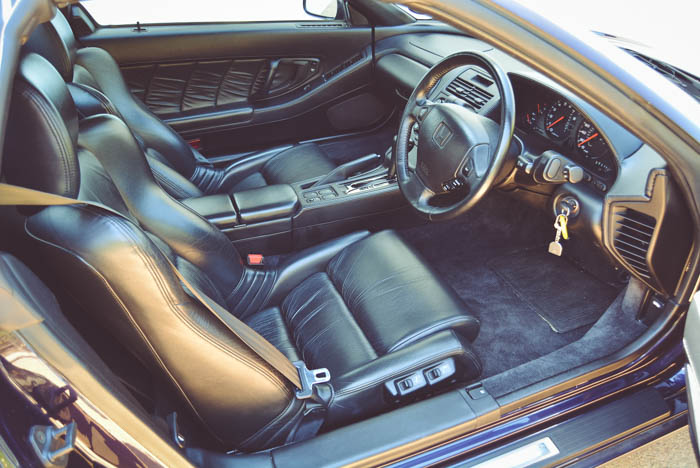
16 Feb COLLECTION IN ACTION – N
An alphabetical series of short driving impressions of some of the museum’s car collection. This month we take a spin (literally!) in an NSX, Honda’s first sports car that bloodied Ferrari’s nose.
A little over a quarter of a century ago, Honda – at the time cementing its reputation for engineering integrity powering both Williams and McLaren to F1 manufacturers’ championship titles – took a shot at the supercar world with a New Sportscar eXperimental (NSX), with the Ferrari 328GTB firmly in the cross hairs. The project had begun in 1984 with the 2,0-litre V6 HP-X (Honda Pininfarina eXperimental) concept car, which was developed to challenge the V8 Ferraris of the time. Created by a team led by chief designer Masahito Nakano and executive chief engineer Shigeru Uehara, the NSX benefitted from advanced aerodynamics and styling inspired by an F-16 fighter jet cockpit and, in the closing stages of development, by input from the late F1 World Champion Ayrton Senna, who was then contracted to McLaren-Honda.
Launched at the 1989 Chicago Auto Show, the NSX went on sale the following year and was the world’s first mass-produced car to feature all-aluminium bodywork, said to have saved around 135 kg over a steel equivalent. Powering the NSX was an all-aluminium 3,0-litre V6 engine mounted transversely amidships. It featured Honda’s then still new but now famous VTEC (Variable valve Timing and lift Electronic Control) system, and with a compression ratio of 10,2:1, the fuel-injected 2 977 cm3 quad-cam 24-valve motor pumped out 201 kW at 7 300 r/min and 285 N.m of torque at 6 500 – the rev limit was 8 000. Transmission options were a five-speed manual and a four-speed SportsShift auto, taking drive to the rear wheels.
Double wishbones, coils springs and an anti-roll bar suspended the car both front and rear, and all-round disc brakes had ABS. Rack-and-pinion steering operated on cast alloy road wheels, 15-inch with 205/50 tyres up front and 16-inch with 225/50s at the back.
Wind tunnel testing helped develop the car’s overall shape that featured a faired-in full-width wing at the rear. Apart from necessary engine air intakes in the flanks, the NSX’s shape is fuss free and smooth, which may have worked against it though, because while being airy, spacious (it even boasts a usable boot), solidly built and easy to drive – rarities in 1980s supercar attributes – it lacked the visual drama and, at the time, the cachet of a Ferrari or even Lamborghini. That it performed, rode and handled as well as, if not better than the (now 348) GTB did not have the marketing impact it should have. This was Honda’s first supercar, remember…
And Ferrari could not boast road car design input from an F1 champion as Honda could with Senna. In February 1989, a McLaren test session coincided with an NSX test and, after driving the car, the Brazilian master suggested that the car flexed too much so Honda’s engineers went away dialled-in 50% more torsional rigidity in a remarkably short time. In the run-up to production, Senna continued to help develop improvements to the car’s dynamics.
Once on sale, the NSX received critical acclaim from all who drove it. Honda had pioneered the affordable, user-friendly supercar to the extent that Gordon Murray was said to have benchmarked the NSX when he was designing the McLaren F1 road car, while Ferrari quickly set about replacing the 348 with the F355. Today, it still looks good and FMM’s metallic purple Targa-topped example is quite stunning. With just under 18 000 km on the odo, it is as fresh as the day it was built.
Stepping down into the cockpit, it oozes solid build quality. The seats offer plenty of legroom even for my 1,86-metre frame and the ample glasshouse offers an all-round vista. Two control-laden arms protruding from the column seem a little at odds with the rest of the cabin layout, which is clearly labelled and easy to operate. Manual override of the SportsShift transmission is via a single small lever mounted just behind the steering wheel on the left (paddle shifters had yet to become the vogue) and it works crisply enough.
Typical of VTEC engines, the V6 thrives on revs and the NSX is no exception although the resultant bark from the twin exhausts is muted by supercar standards – it certainly does not penetrate the cabin – but is still crisp enough to be enjoyed. Performance-wise, the NSX was credited with a 0-100 km/h time of 6,0 seconds and a top speed of 270 km/h, and it delivers with admirable ease. Combined with a firm but not harsh ride, benign handling and solid, communicative steering, the NSX set a benchmark in user-friendly superformance that did not cost a fortune to experience.
Initially available as a coupé, a Type-R was made available in 1992, the targa-top version was introduced in 1995 and in 1997 the engine became a 3,2-litre V6 coupled with a six-speed gearbox. A facelift took place in 2002 but the model was discontinued in 2005. In America, the car was named the Acura NSX and marketed as the halo model for Honda’s fledgling Stateside brand. Yet total NSX sales were reported to be less than 20 000. This has to be one of performance motoring’s best kept secrets… MM











